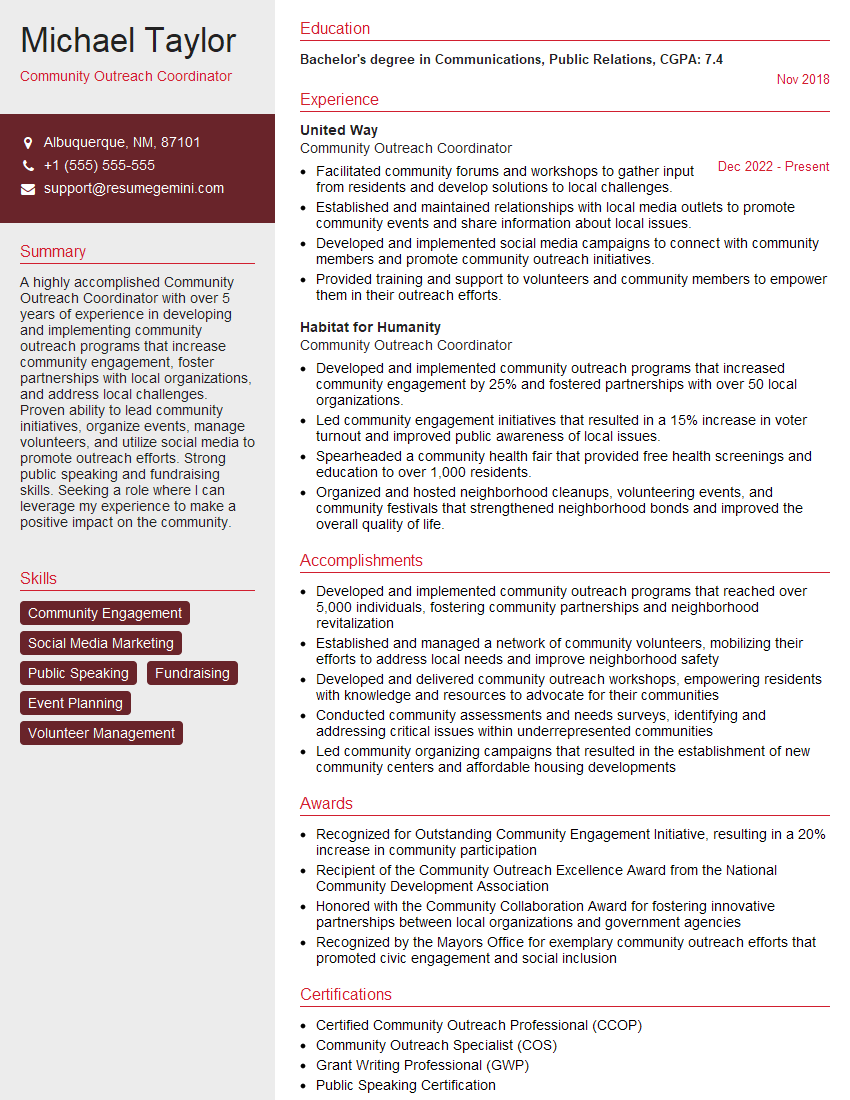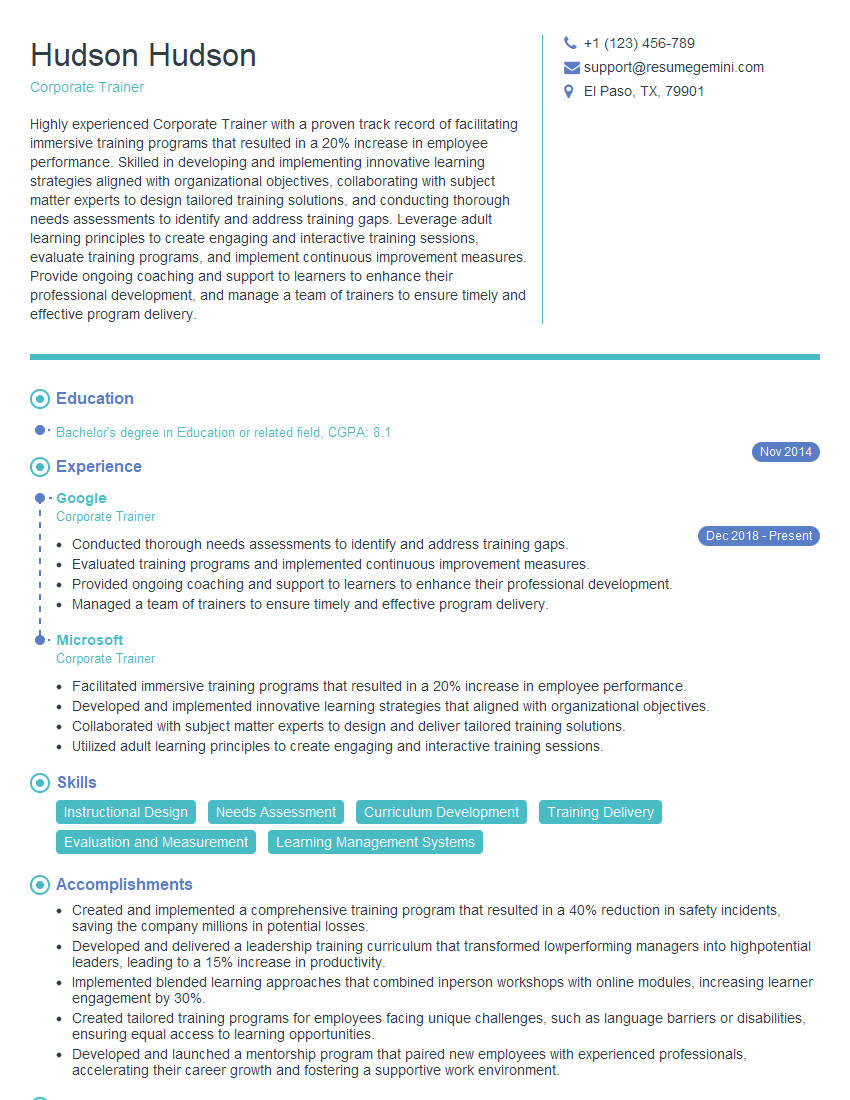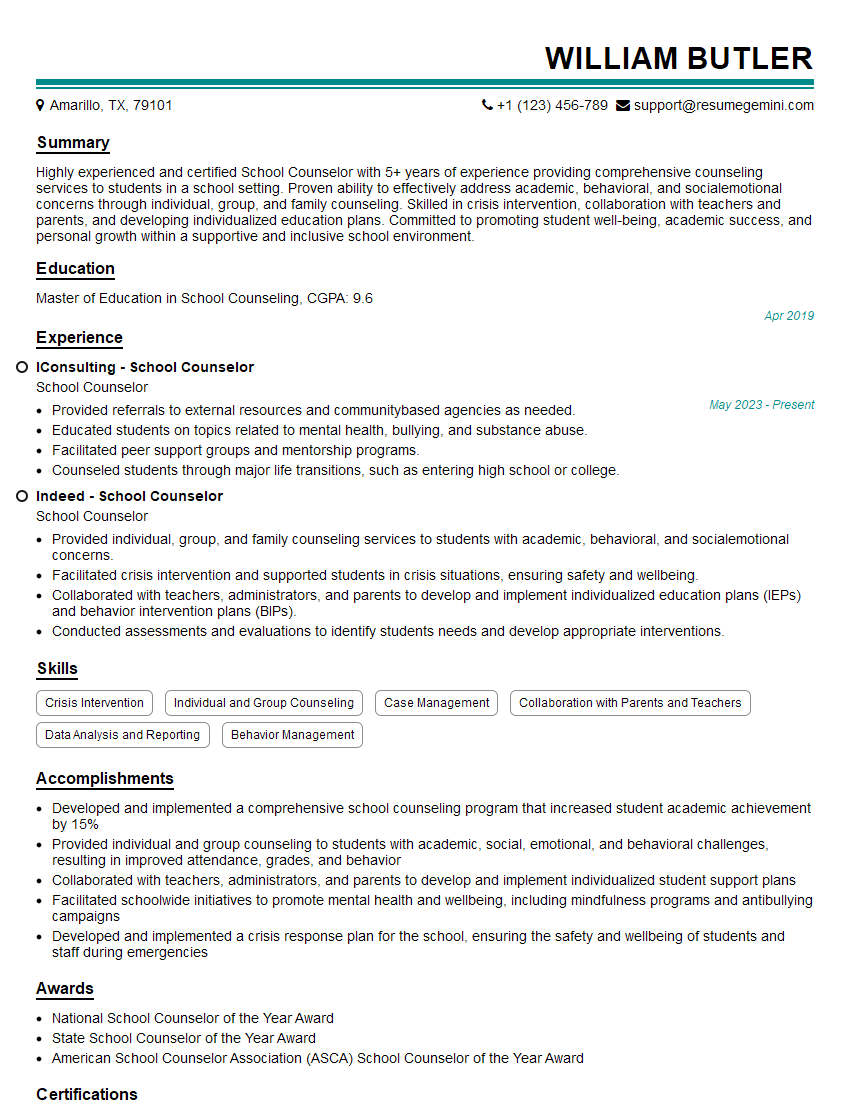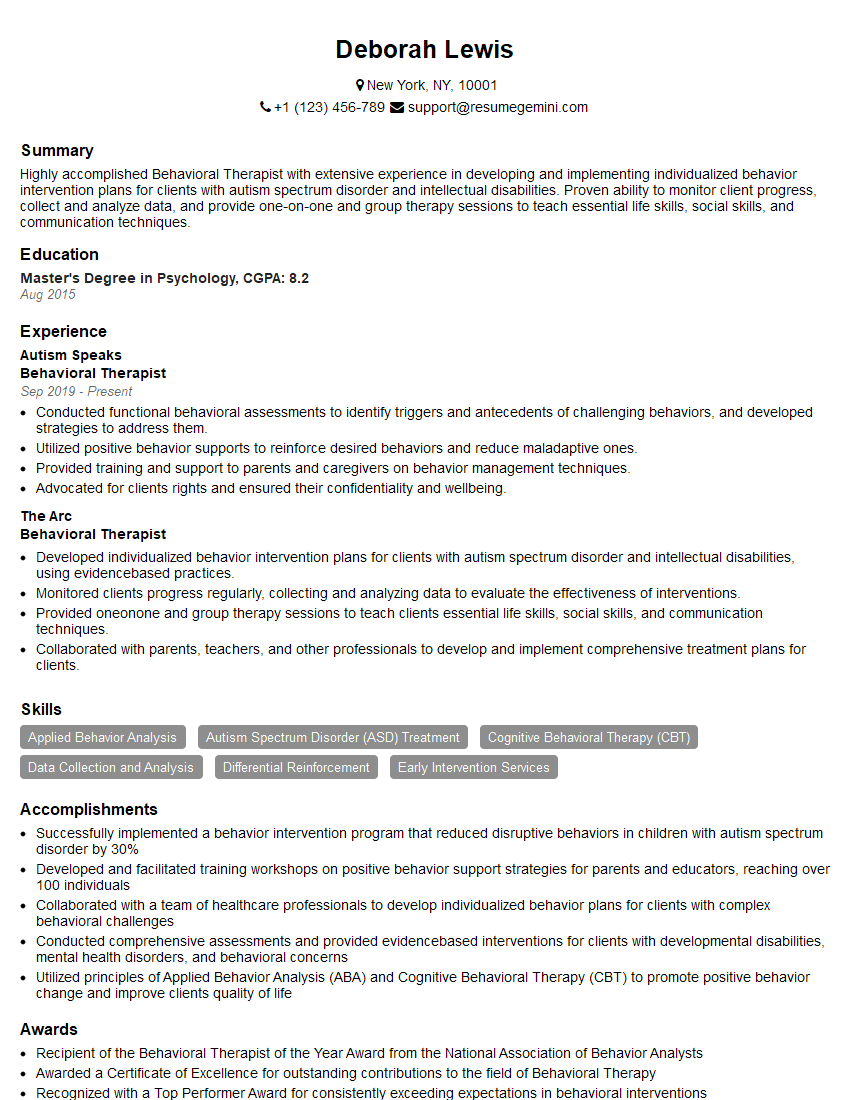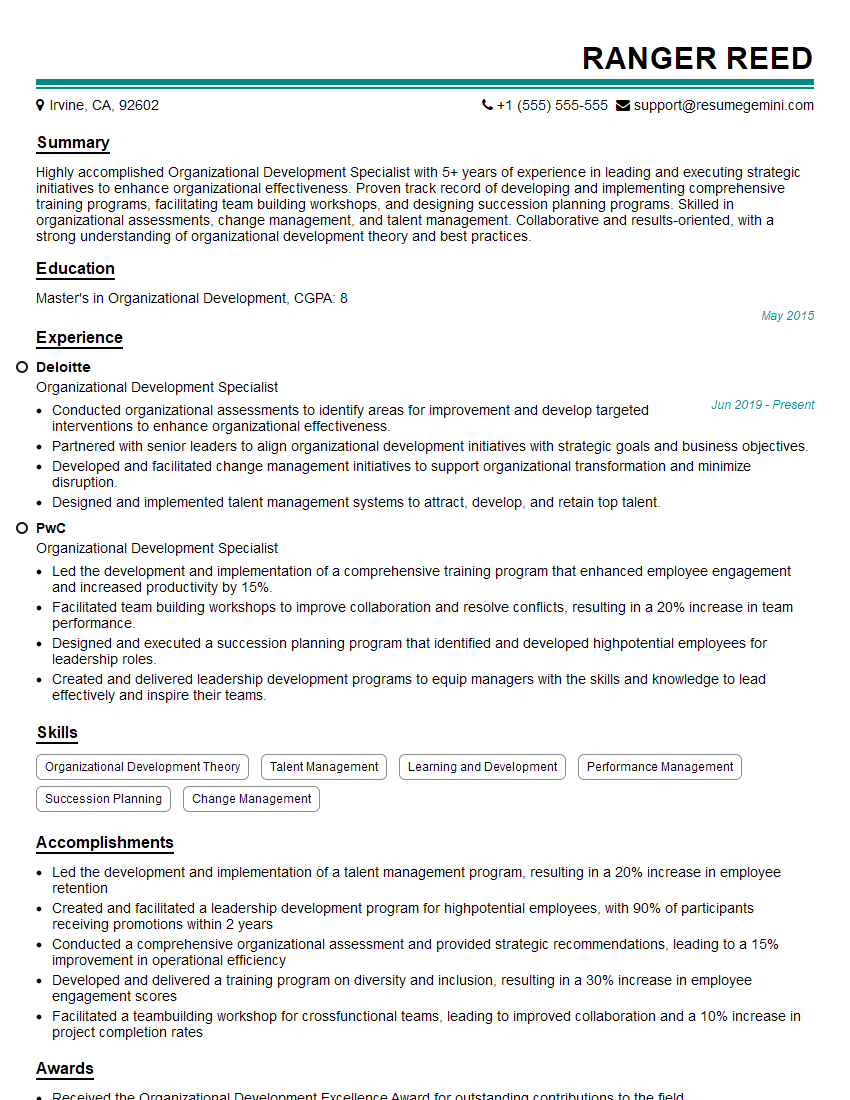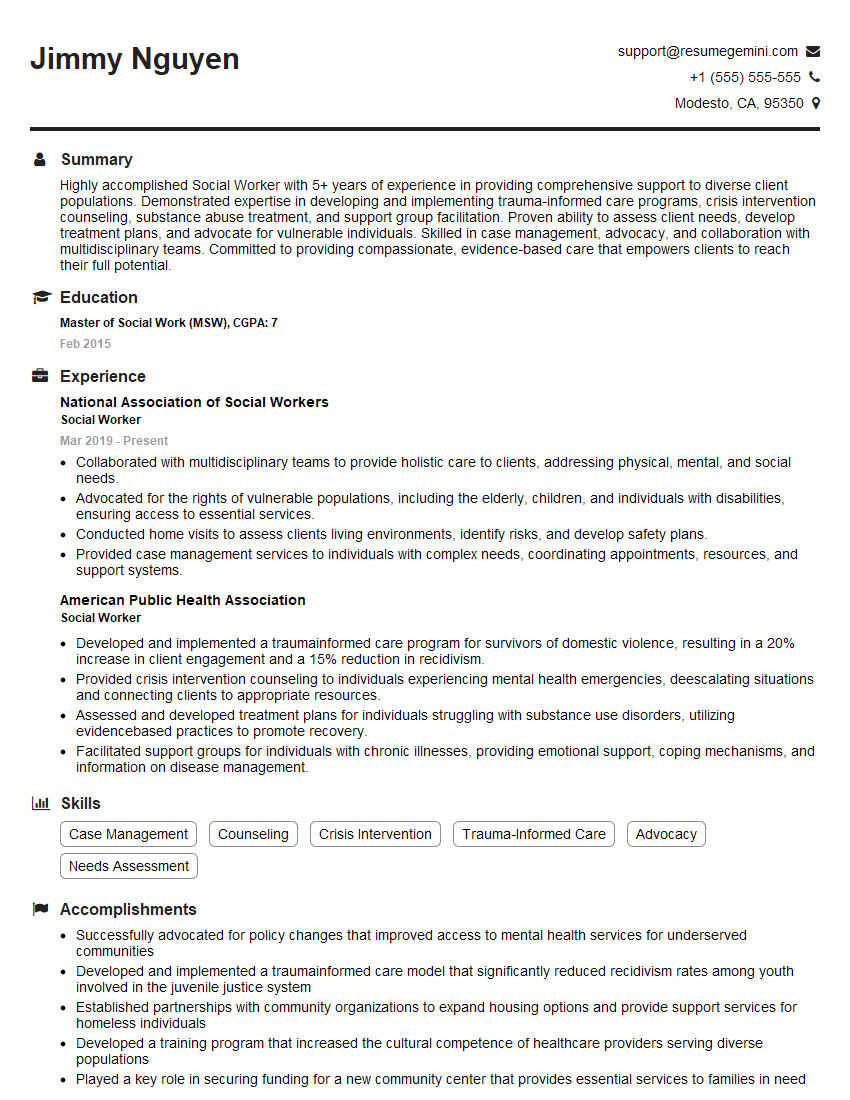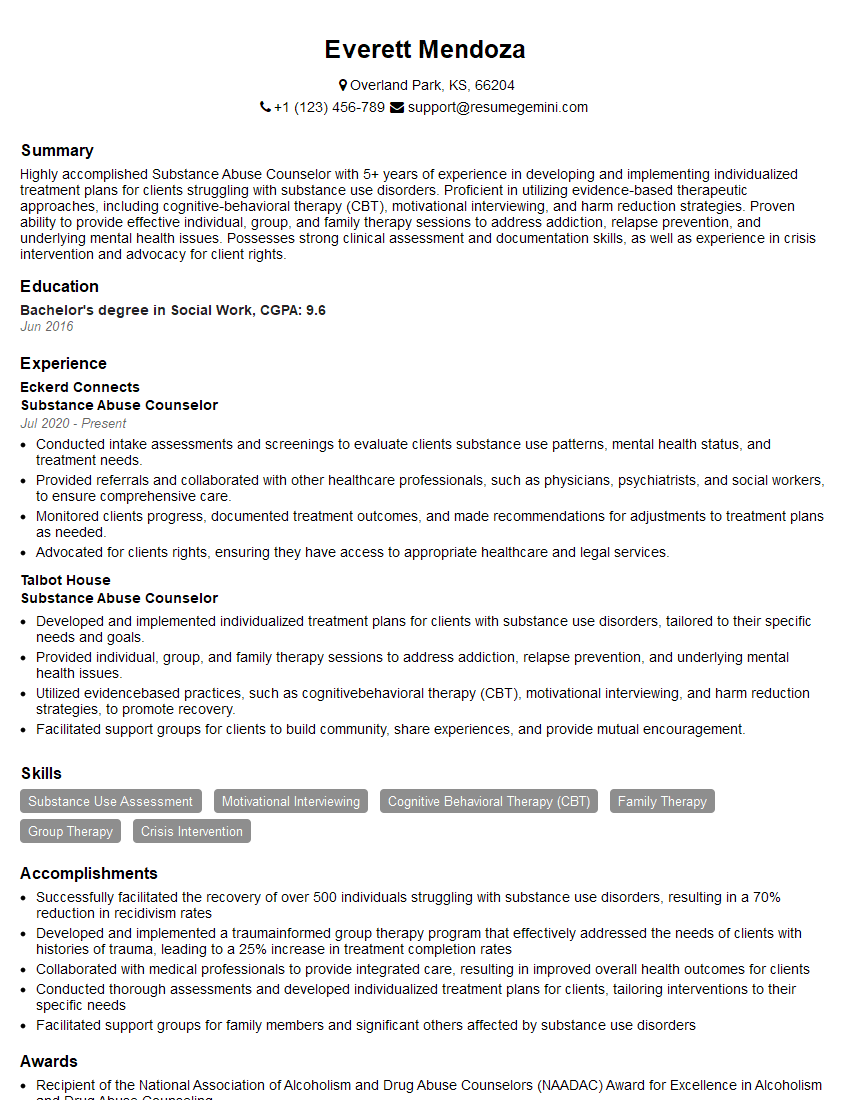Every successful interview starts with knowing what to expect. In this blog, we’ll take you through the top Character Building interview questions, breaking them down with expert tips to help you deliver impactful answers. Step into your next interview fully prepared and ready to succeed.
Questions Asked in Character Building Interview
Q 1. Describe your approach to fostering ethical decision-making in individuals.
Fostering ethical decision-making involves cultivating a strong moral compass in individuals. This isn’t about simply memorizing rules, but rather developing a deep understanding of ethical principles and the ability to apply them to real-life situations. My approach is multifaceted and focuses on three key areas:
- Moral Reasoning: I utilize case studies, ethical dilemmas, and role-playing exercises to encourage critical thinking and analysis. For example, we might explore a scenario involving plagiarism and discuss the various perspectives and consequences. This helps individuals develop their own frameworks for making ethical choices.
- Empathy and Perspective-Taking: Understanding the impact of our actions on others is crucial. I incorporate activities that promote empathy, such as service learning projects or discussions about different cultural perspectives on ethical issues. This allows participants to consider the broader consequences of their decisions.
- Character Strengths: Ethical decision-making is often supported by character strengths like honesty, fairness, and responsibility. I integrate activities that encourage the development of these strengths, such as reflection exercises, goal setting, and feedback sessions. This helps individuals build the inner resources they need to act ethically even when faced with difficult choices.
Ultimately, the goal is to move individuals beyond simply following rules to actively engaging in ethical reflection and consistently making morally sound choices.
Q 2. How do you measure the effectiveness of a character building program?
Measuring the effectiveness of a character building program requires a multi-pronged approach, going beyond simple attendance or completion rates. We need both qualitative and quantitative data to get a comprehensive picture.
- Quantitative Measures: These include pre- and post-program assessments using validated questionnaires to measure changes in self-reported ethical behavior, resilience, empathy, and other relevant character traits. We might also track participation rates and completion rates of program components.
- Qualitative Measures: This involves gathering rich data through observations, focus groups, interviews, and analyzing reflections from participants. This helps us understand the nuances of their experiences and the impact of the program on their thinking and behavior. For instance, interviews can provide deeper insights into how participants apply what they learned in real-world scenarios.
- Behavioral Observations: Changes in behavior are a critical indicator of program success. This could involve observations in classroom settings (if the program is school-based) or through reports from parents or mentors.
By combining quantitative and qualitative data, we gain a holistic understanding of the program’s effectiveness and can identify areas for improvement.
Q 3. Explain your understanding of the stages of moral development.
My understanding of moral development is largely informed by Kohlberg’s stages of moral reasoning. This framework suggests that moral development progresses through several stages, moving from a focus on self-interest to a concern for universal ethical principles.
- Pre-conventional Morality (Stage 1 & 2): Focused on self-interest and avoiding punishment. At stage 1, morality is based on obedience and fear of punishment, while stage 2 involves self-interest and exchange (reciprocity).
- Conventional Morality (Stage 3 & 4): Individuals conform to social expectations and laws. Stage 3 emphasizes good interpersonal relationships and maintaining social order, while stage 4 focuses on upholding laws and social systems.
- Post-conventional Morality (Stage 5 & 6): Individuals develop their own ethical principles based on universal justice and human rights. Stage 5 reflects a social contract orientation, and stage 6 represents universal ethical principles.
It’s important to note that not everyone reaches the highest stages, and individuals may demonstrate different levels of moral reasoning in various contexts. Understanding these stages helps us tailor our character building approaches to meet individuals where they are in their moral development.
Q 4. What strategies do you use to build resilience in individuals facing adversity?
Building resilience involves equipping individuals with the skills and mindsets to bounce back from adversity. My strategies focus on several key areas:
- Mindfulness and Emotional Regulation: Teaching techniques like mindfulness and deep breathing can help individuals manage stress and regulate their emotions effectively in challenging situations. This enables them to respond to adversity more thoughtfully and avoid impulsive reactions.
- Problem-Solving Skills: Developing effective problem-solving skills allows individuals to approach challenges in a structured and systematic way, breaking down complex problems into smaller, manageable steps. This fosters a sense of control and efficacy in the face of adversity.
- Positive Self-Talk and Growth Mindset: Promoting positive self-talk and a growth mindset helps individuals view challenges as opportunities for learning and growth. This reframes setbacks as valuable learning experiences rather than insurmountable obstacles.
- Social Support Networks: Building strong social support networks provides individuals with a sense of belonging and access to help when needed. This could involve group activities, mentoring, or connecting individuals with community resources.
By fostering these skills, individuals can develop a sense of inner strength and the ability to navigate life’s inevitable challenges with greater confidence and resilience.
Q 5. How would you address a situation where a participant in a character building program exhibits disruptive behavior?
Addressing disruptive behavior in a character building program requires a calm, empathetic, and consistent approach. It’s crucial to understand the underlying reasons for the behavior before implementing any interventions.
- Understanding the Root Cause: Engage in a private conversation with the participant to understand their motivations. Are they feeling frustrated, overwhelmed, or excluded? Are there unmet needs or underlying issues contributing to their behavior?
- Setting Clear Expectations and Boundaries: Clearly communicate expectations for appropriate behavior and the consequences of disruptive actions. These should be consistent and fair.
- Restorative Practices: Use restorative practices to address harm caused by the disruptive behavior. This might involve facilitating a conversation between the participant and those affected by their actions to repair relationships and promote understanding.
- Positive Reinforcement: Acknowledge and reward positive behaviors to encourage a shift in the participant’s actions. This is far more effective than focusing solely on punishing negative behaviors.
- Collaboration and Support: Work collaboratively with parents, teachers, or other relevant stakeholders to provide consistent support and guidance to the participant.
Addressing disruptive behavior requires patience and a focus on understanding and support. The goal is not to punish but to help the individual learn and grow from their mistakes.
Q 6. What are some common challenges in implementing character building initiatives in schools?
Implementing character building initiatives in schools often faces numerous challenges:
- Lack of Time and Resources: Schools often have limited time and resources to dedicate to character education programs. This can make it difficult to implement comprehensive and effective initiatives.
- Curriculum Constraints: Integrating character education into an already crowded curriculum can be challenging. Finding the time and space for dedicated character education activities requires careful planning and prioritization.
- Measuring Impact: Demonstrating the effectiveness of character education programs can be difficult. This requires careful selection of assessment tools and a commitment to data collection and analysis.
- Teacher Training and Support: Teachers need adequate training and ongoing support to effectively implement character education programs. Without adequate professional development, programs may not be implemented effectively.
- Lack of Parental and Community Involvement: Effective character building requires a partnership between schools, parents, and the wider community. Without active involvement from all stakeholders, the impact of the program may be limited.
Addressing these challenges requires a strong commitment from school leaders, teachers, parents, and the wider community. Careful planning, resource allocation, and ongoing evaluation are essential for success.
Q 7. How do you adapt your character building strategies to different age groups?
Adapting character building strategies to different age groups is crucial for their effectiveness. Young children, adolescents, and adults all learn and process information differently, requiring tailored approaches.
- Young Children (Preschool – Early Elementary): Focus on foundational character strengths like kindness, honesty, and responsibility through storytelling, role-playing, and hands-on activities. Use simple language and visual aids to convey concepts.
- Adolescents (Middle and High School): Explore more complex ethical dilemmas and encourage critical thinking skills. Involve them in service learning projects and peer mentoring to foster leadership and empathy. Focus on self-awareness, identity development, and goal setting.
- Adults: Focus on advanced moral reasoning, ethical leadership, and the development of professional ethics. Use case studies, simulations, and discussions to explore complex ethical issues. Encourage self-reflection, goal setting, and feedback to support ongoing personal and professional growth.
By understanding the developmental needs and cognitive abilities of each age group, we can create engaging and effective character building programs that promote positive character development at every stage of life.
Q 8. Describe your experience developing and delivering character education curriculum.
Developing and delivering character education curricula requires a multifaceted approach. It begins with a deep understanding of the target audience’s developmental stage and needs. I start by identifying core character traits – such as honesty, responsibility, empathy, and perseverance – that are relevant and achievable. Then, I design engaging activities, lessons, and assessments that cater to various learning styles. This might involve interactive games, role-playing exercises, storytelling, real-world case studies, and community service projects. For example, in a curriculum for middle schoolers, I might develop a role-playing activity where students simulate navigating a challenging social situation, requiring them to use empathy and communication skills to resolve the conflict. The curriculum also includes mechanisms for ongoing assessment – both formative (ongoing checks for understanding) and summative (end-of-unit evaluations) to ensure student progress and adaptation of the curriculum as needed.
Furthermore, effective delivery involves creating a positive and supportive classroom environment where students feel safe taking risks, making mistakes, and learning from their experiences. I emphasize active participation and reflection, encouraging students to connect classroom learning to their lives outside of school. My experience includes developing and implementing curricula for diverse age groups, from elementary school to high school, adapting my approach to suit their unique developmental needs and learning preferences.
Q 9. Explain your understanding of the role of social-emotional learning in character development.
Social-emotional learning (SEL) is absolutely crucial for character development. It’s the foundation upon which strong character traits are built. SEL focuses on the development of self-awareness, self-management, social awareness, relationship skills, and responsible decision-making. These skills are not simply ‘nice-to-haves’; they are essential for navigating complex social situations, building healthy relationships, and making ethical choices. For instance, a child who lacks self-regulation might struggle to control their impulses, leading to conflict with peers. SEL interventions help develop skills to manage emotions and behavior, directly impacting their ability to demonstrate responsible conduct. Similarly, understanding the emotions and perspectives of others (social awareness) is vital for empathy and effective teamwork, key components of good character.
I incorporate SEL into my character education programs through explicit instruction, modeling positive behaviors, and providing opportunities for students to practice these skills in a safe and supportive environment. This involves providing direct teaching on topics like emotional regulation, conflict resolution, and perspective-taking, followed by opportunities for practice through collaborative projects, discussions, and problem-solving activities. A successful program integrates SEL throughout all aspects of character building, making it an integral part of the learning process rather than an add-on.
Q 10. How do you incorporate feedback to improve your character building programs?
Feedback is essential for continuous improvement in any character building program. I utilize a multi-pronged approach to collect and incorporate feedback, employing both quantitative and qualitative methods. Quantitative data might include pre- and post-program assessments measuring changes in students’ attitudes, behaviors, or knowledge. Qualitative data comes from various sources such as student feedback surveys, teacher observations, parent interviews, and focus groups. For instance, a student survey might ask about their experience in a particular activity, their perceived learning, and suggestions for improvement. Teacher observations could track students’ behavior in the classroom and during group activities.
The feedback collected is then analyzed to identify areas of strength and weakness in the program. For example, if feedback reveals that a particular activity was ineffective or engaging, I will revise or replace it. If student surveys indicate a lack of understanding of a certain concept, I’ll adapt my teaching strategies to address that gap. By systematically incorporating feedback, I ensure the program remains relevant, engaging, and impactful, adapting it to meet the evolving needs of students and the broader context.
Q 11. What are the key components of a successful mentorship program?
A successful mentorship program hinges on several key components. First, careful matching of mentors and mentees is critical. Mentors should possess relevant life experiences, strong communication skills, and a genuine commitment to guiding their mentees. Similarly, mentees should be selected based on their needs and readiness for mentorship. Clear goals and expectations should be established at the outset, ensuring both parties understand the program’s aims and their respective roles. Regular meetings are crucial, providing a structured environment for discussion and support. These meetings shouldn’t just be transactional; they should foster a genuine connection between the mentor and mentee.
Beyond structured meetings, opportunities for shared activities – like volunteering or attending events – strengthen the mentor-mentee bond. The program should also incorporate mechanisms for evaluation and feedback, allowing for adjustments and improvements. For example, regular check-ins between the program coordinator and both mentors and mentees can provide valuable insights into the program’s effectiveness. Finally, providing training and ongoing support for mentors is vital for their success and the program’s overall effectiveness. This might include workshops on communication, active listening, and conflict resolution.
Q 12. How do you foster a culture of empathy and respect within a group setting?
Fostering a culture of empathy and respect requires a proactive and multifaceted approach. It begins with establishing clear expectations and norms for respectful behavior. This might involve collaboratively creating a classroom code of conduct, emphasizing the importance of valuing diverse perspectives, and actively modeling empathy and respect in interactions. Activities that promote perspective-taking are crucial; for example, role-playing exercises where students step into the shoes of others can help them understand different viewpoints. Discussions about social justice issues and current events can spark meaningful conversations and raise awareness of systemic inequalities.
Furthermore, providing opportunities for students to collaborate on projects or participate in community service activities can strengthen their sense of belonging and shared responsibility. Active listening is paramount – encouraging students to actively listen to each other’s perspectives, even if they disagree. Addressing conflicts constructively – rather than resorting to punishment – allows students to learn conflict resolution skills and build empathy towards those with whom they disagree. Creating a safe space where students feel comfortable expressing themselves honestly and respectfully is paramount. Regular reinforcement of these values through positive feedback and recognition of respectful behavior is crucial to solidify this culture.
Q 13. Describe your experience in conflict resolution and mediation.
My experience in conflict resolution and mediation draws heavily on active listening, empathy, and a non-judgmental approach. I’ve facilitated numerous conflict resolution sessions, both formally and informally, utilizing various techniques depending on the situation. In formal mediation, I work to create a safe space for all parties involved to express their perspectives without interruption. I employ active listening to understand each person’s concerns and needs, summarizing their viewpoints to ensure mutual understanding. My aim is not to assign blame but to help the parties identify common ground and explore solutions that work for everyone involved. I might use techniques like reframing statements, helping individuals understand the situation from the other’s perspective, and proposing potential compromises.
In informal conflict resolution, I might intervene during a classroom disagreement, guiding students through a process of identifying the problem, expressing their feelings constructively, and brainstorming solutions together. The key in both formal and informal settings is to remain neutral and impartial, guiding the process while empowering the individuals to find their own solutions. My experience includes mediating conflicts among students, teachers, and parents, emphasizing a restorative justice approach where the focus is on repairing relationships and addressing the underlying causes of the conflict.
Q 14. How do you promote critical thinking and problem-solving skills in relation to ethical dilemmas?
Promoting critical thinking and problem-solving skills in relation to ethical dilemmas requires a structured approach. I often use case studies, simulations, or hypothetical scenarios that present students with ethical challenges. For example, I might present a scenario involving plagiarism or cyberbullying, asking students to analyze the situation from multiple perspectives. I encourage students to identify the key ethical issues, consider the consequences of different actions, and justify their decisions based on ethical principles. This process involves more than just identifying the ‘right’ answer; it focuses on developing their reasoning skills and ability to support their conclusions with evidence.
I often employ the Socratic method, asking probing questions to encourage deeper reflection and critical analysis. Students are challenged to articulate their reasoning, justify their choices, and consider alternative perspectives. Discussions around ethical frameworks, such as utilitarianism or deontology, can provide a theoretical basis for understanding ethical decision-making. It’s crucial to create a safe space for open discussion, where students feel comfortable exploring different viewpoints without fear of judgment. By actively engaging students in ethical discussions and problem-solving activities, I aim to foster their ethical reasoning and decision-making abilities, preparing them to navigate ethical challenges in their lives.
Q 15. What are some effective methods for teaching self-regulation and emotional intelligence?
Teaching self-regulation and emotional intelligence requires a multifaceted approach focusing on both cognitive and affective learning. We can’t simply lecture children about managing emotions; we need to equip them with practical skills and strategies.
Mindfulness Practices: Techniques like deep breathing exercises, meditation, and body scans help children become more aware of their emotions and bodily sensations, giving them a pause before reacting impulsively. For example, incorporating a short mindfulness activity at the start of each school day can create a calm and focused learning environment.
Emotional Vocabulary Building: Helping children identify and label their feelings is crucial. We can use feeling charts, storybooks, or even role-playing to expand their emotional lexicon. Instead of simply saying “I’m mad,” a child might learn to express, “I feel frustrated because…” This increased vocabulary allows for more nuanced emotional understanding and communication.
Social-Emotional Learning (SEL) Curricula: Structured SEL programs provide a framework for teaching self-awareness, self-management, social awareness, relationship skills, and responsible decision-making. These programs often use interactive activities, games, and discussions to foster emotional literacy and prosocial behavior.
Cognitive Behavioral Techniques (CBT): CBT strategies, such as identifying negative thought patterns and replacing them with more positive and realistic ones, can help children manage anxiety and stress. For instance, a child worried about a test can be taught to reframe their thoughts from “I’m going to fail” to “I can prepare well and do my best.”
Modeling and Positive Reinforcement: Adults serve as powerful role models. Consistently demonstrating self-regulation and emotional intelligence, along with providing positive reinforcement for children’s efforts, reinforces desired behaviors. For example, acknowledging and praising a child’s attempt to calm down after feeling upset provides valuable feedback.
Career Expert Tips:
- Ace those interviews! Prepare effectively by reviewing the Top 50 Most Common Interview Questions on ResumeGemini.
- Navigate your job search with confidence! Explore a wide range of Career Tips on ResumeGemini. Learn about common challenges and recommendations to overcome them.
- Craft the perfect resume! Master the Art of Resume Writing with ResumeGemini’s guide. Showcase your unique qualifications and achievements effectively.
- Don’t miss out on holiday savings! Build your dream resume with ResumeGemini’s ATS optimized templates.
Q 16. How do you assess the long-term impact of a character building intervention?
Assessing the long-term impact of character building interventions requires a longitudinal approach that goes beyond immediate post-intervention measures. We need to track changes over time to truly understand the lasting effects.
Follow-up Surveys and Interviews: Conducting surveys and interviews with participants at regular intervals (e.g., 6 months, 1 year, 5 years post-intervention) allows us to gather data on their self-reported behaviors, attitudes, and perceptions. These should include open-ended questions to gain deeper insights into their experiences.
Behavioral Observations: In settings where appropriate, observing participants’ behavior in relevant contexts (school, workplace, community) can provide valuable qualitative data on how the intervention has translated into real-world actions.
Academic and Professional Outcomes: Examining academic performance, workplace success, and civic engagement can reveal the broader impact of character building. For instance, are participants demonstrating greater responsibility, resilience, or leadership skills?
Comparative Analysis: Comparing outcomes between a control group (who did not receive the intervention) and the intervention group helps determine the effectiveness of the program and isolate the effects of the intervention.
Qualitative Data Analysis: Analyzing themes and patterns emerging from interviews and observations can provide rich insights into the participants’ experiences and the mechanisms through which the intervention has impacted their character development. This might involve looking for narratives of increased self-efficacy, improved relationships, or greater sense of purpose.
Q 17. Describe your experience working with diverse populations in a character building context.
My experience working with diverse populations in character building has underscored the critical need for culturally responsive and inclusive approaches. I’ve worked with children from various socioeconomic backgrounds, ethnicities, and religious beliefs, each bringing their unique perspectives and challenges.
For example, in a program with refugee children, I found that building trust and rapport was paramount. Understanding their prior experiences and adapting the curriculum to incorporate their cultural contexts was essential to their engagement. We used storytelling and art therapy to create safe spaces for them to express their emotions and build resilience. Similarly, working with adolescents from marginalized communities required a focus on social justice and empowerment, integrating discussions about fairness, equity, and their rights into the character building activities.
In each case, successful engagement required careful consideration of cultural nuances, communication styles, and individual needs. It involved creating a learning environment that valued their unique identities and empowered them to navigate the challenges they faced.
Q 18. How do you ensure the inclusivity and equity of your character building programs?
Ensuring inclusivity and equity in character building programs requires proactive measures at every stage, from design to implementation.
Culturally Responsive Curriculum: The curriculum must be designed to resonate with the diverse backgrounds and experiences of the participants. This involves incorporating diverse narratives, examples, and activities that reflect the lived realities of the community.
Equitable Access: Programs should be accessible to all participants, regardless of their socioeconomic status, disability, or other factors. This may involve offering scholarships, providing accessible materials, and employing culturally competent staff.
Inclusive Pedagogy: Teaching methods should cater to diverse learning styles and needs. Differentiated instruction, collaborative learning, and active participation are key elements of an inclusive approach.
Addressing Systemic Inequalities: Character building programs should not only focus on individual development but also address the systemic inequalities that impact the participants’ lives. This may involve engaging in discussions about social justice, advocating for policy changes, or partnering with community organizations.
Feedback Mechanisms: Regularly seeking feedback from participants and stakeholders allows for continuous improvement and ensures that the program remains relevant and responsive to the needs of the community.
Q 19. Explain your knowledge of different theoretical frameworks of character development.
My understanding of character development draws on several theoretical frameworks. These are not mutually exclusive but rather complementary perspectives that inform my practice.
Virtue Ethics: This approach emphasizes the cultivation of virtuous character traits, such as honesty, compassion, and courage, through moral reasoning and practice. It focuses on developing strong moral character through habitual actions and internalizing moral values.
Cognitive-Developmental Theory: This perspective highlights the role of cognitive development in moral reasoning and behavior. It suggests that character development is a gradual process involving the development of increasingly complex moral reasoning skills. Piaget and Kohlberg’s work significantly contribute to this understanding.
Social Learning Theory: This emphasizes the importance of observational learning and social modeling in character development. It suggests that individuals learn moral behaviors by observing and imitating role models. Bandura’s work is seminal here.
Positive Psychology: This framework focuses on strengths and virtues, aiming to foster flourishing and well-being. It emphasizes the importance of positive emotions, engagement, relationships, meaning, and accomplishment in character development.
By integrating these frameworks, I create comprehensive character building programs that address both cognitive and affective aspects of moral development, considering both individual and social factors.
Q 20. What are the ethical considerations when implementing character building programs?
Ethical considerations are central to character building programs. We must ensure that our interventions are respectful, equitable, and do not cause harm.
Informed Consent: Participants (or their guardians) must be fully informed about the program’s goals, methods, and potential risks before participating. Their voluntary consent is crucial.
Confidentiality: Information shared during the program must be kept confidential, unless there is a legal obligation to disclose it (e.g., child protection concerns).
Cultural Sensitivity: Programs must be designed and implemented with sensitivity to the cultural values and beliefs of the participants. Stereotyping and biases must be avoided.
Avoidance of Coercion: Participants should never feel pressured or coerced into participating or conforming to specific values. A focus on intrinsic motivation is key.
Beneficence and Non-Maleficence: The primary goal is to benefit participants and avoid causing harm. Careful consideration must be given to the potential unintended consequences of interventions.
Q 21. How do you handle resistance or skepticism towards character building initiatives?
Resistance or skepticism towards character building initiatives often stems from misunderstandings about the program’s goals and methods. Addressing these concerns requires open communication, transparency, and a collaborative approach.
Open Dialogue and Education: Engage skeptics in respectful dialogue, explaining the program’s rationale, evidence base, and expected outcomes. Provide clear information about the methods used and address their specific concerns.
Demonstration of Effectiveness: Showcasing data on the program’s effectiveness can help alleviate skepticism. Sharing testimonials from past participants or presenting research findings can build trust and confidence.
Collaborative Program Design: Involving stakeholders, including those who may be skeptical, in the design and implementation of the program can foster ownership and reduce resistance.
Data-Driven Evaluation: Regular evaluation and data collection allows for demonstrating the program’s impact and making necessary adjustments. Transparency about the evaluation process and findings is important.
Focus on Practical Application: Highlighting the practical benefits of character building, such as improved academic performance, stronger relationships, and enhanced emotional well-being, can appeal to a broader audience.
Q 22. What are the potential challenges of integrating technology into character building programs?
Integrating technology into character building programs offers exciting possibilities, but it also presents unique challenges. One key concern is the potential for increased screen time and its negative impact on social interaction and physical activity, undermining the very aspects of character we aim to cultivate. Another challenge lies in ensuring equitable access to technology and digital literacy training. Not everyone has equal access to devices or the skills to use them effectively, creating a digital divide that can exacerbate existing inequalities. Furthermore, the risk of cyberbullying, online predators, and exposure to inappropriate content necessitates careful curation and robust safety measures. Finally, over-reliance on technology can diminish the importance of face-to-face interaction and the development of crucial interpersonal skills, such as empathy and conflict resolution, which are fundamental to strong character.
For example, a program using online games to teach teamwork could inadvertently promote unhealthy competition or lead to frustration if not carefully designed and moderated. It’s crucial to integrate technology thoughtfully, balancing its potential benefits with the need to mitigate its risks. This includes prioritizing digital wellbeing, providing comprehensive training, and continually assessing the impact of technology on the program’s overall goals.
Q 23. How do you ensure the sustainability of character building programs beyond initial implementation?
Sustainability of character building programs requires a multi-pronged approach. Firstly, building strong relationships with stakeholders is paramount. This involves securing buy-in from community leaders, parents, educators, and the participants themselves. Secondly, incorporating the program into existing structures, such as schools or community centers, ensures its longevity by making it a regular part of people’s lives. Thirdly, developing a clear and measurable framework for evaluation allows for continuous improvement and demonstrates the program’s impact to funders and stakeholders, securing ongoing support. Finally, training local leaders and community members to facilitate the program creates ownership and ensures its continuity even after initial funding ends.
Imagine a character-building program focused on leadership skills. To ensure its sustainability, we’d establish partnerships with local schools, integrate it into their curriculum, and train teachers to deliver the program. We’d also create a system for evaluating student progress and gather feedback to adapt the program over time. This would demonstrate the program’s value, leading to ongoing funding and community support.
Q 24. How do you measure the effectiveness of different character building strategies?
Measuring the effectiveness of character building strategies requires a mixed-methods approach, combining quantitative and qualitative data. Quantitative measures might include pre- and post-program assessments of participants’ attitudes, behaviors, and self-reported levels of various character traits, using validated questionnaires and scales. For example, we might track changes in empathy scores or prosocial behaviors. Qualitative data, obtained through interviews, focus groups, and observations, provides richer insights into the program’s impact on participants’ lived experiences. This might involve gathering testimonials about how the program has influenced their decision-making or relationships. By combining both quantitative and qualitative data, we can gain a comprehensive understanding of the program’s effectiveness and areas for improvement.
For instance, we might use a standardized questionnaire to measure changes in students’ self-reported levels of resilience after participating in a resilience-building program. We would also conduct interviews with students to understand their personal experiences and how the program has influenced their lives. Analyzing both quantitative scores and qualitative narratives would provide a holistic evaluation.
Q 25. How do you build strong relationships with stakeholders involved in character building initiatives?
Building strong relationships with stakeholders requires open communication, active listening, and genuine collaboration. It’s crucial to involve stakeholders in the design and implementation process from the outset, ensuring their needs and perspectives are considered. Regular communication, through meetings, newsletters, or online forums, keeps stakeholders informed about the program’s progress and allows for feedback. Transparency in the use of resources and the program’s outcomes builds trust and fosters a sense of shared ownership. Celebrating successes together and addressing challenges collaboratively strengthens relationships and ensures ongoing support.
In a recent project, I ensured stakeholder engagement by holding regular meetings with school administrators, teachers, parents, and students. I actively sought their input at each stage of the program’s development, creating a sense of shared ownership and increasing the likelihood of long-term success.
Q 26. Describe a time you had to adapt a character building strategy due to unforeseen circumstances.
During a leadership development program, we faced unforeseen circumstances when a key partner organization withdrew its support mid-way through the program due to internal restructuring. This created a significant funding gap and threatened the program’s continuity. To adapt, we immediately explored alternative funding sources, such as grants and community fundraising initiatives. We also re-evaluated the program’s structure to reduce costs without compromising its effectiveness, for example, by utilizing more volunteer facilitators. Simultaneously, we proactively communicated the situation to stakeholders and secured their continued support through transparent updates and demonstrations of our commitment to finding solutions. This crisis ultimately strengthened the program’s resilience and fostered a stronger sense of community ownership.
Q 27. How do you evaluate the needs of a community when developing a character building program?
Evaluating community needs requires a mixed-methods approach that combines quantitative data, such as demographic information and statistical analysis of social issues, with qualitative data gathered through community forums, focus groups, and individual interviews. By understanding the prevalent challenges faced by the community, including issues like poverty, violence, or lack of opportunity, we can identify areas where character building programs can have the greatest impact. This includes understanding the existing resources and support systems within the community and identifying potential partners who can collaborate on program implementation.
For instance, before designing a program, I conducted surveys, held community meetings, and interviewed key informants to understand the specific challenges faced by young people in a particular neighborhood. This revealed a high rate of school dropouts and substance abuse. This helped focus the program’s design on developing resilience and self-efficacy among at-risk youth.
Q 28. What are some innovative approaches to character building that you are familiar with?
Innovative approaches to character building increasingly utilize experiential learning, service-learning, and positive youth development frameworks. Experiential learning engages participants in hands-on activities and real-world challenges that foster critical thinking, problem-solving, and collaboration. Service-learning combines academic study with community service, allowing participants to develop empathy and social responsibility while applying their skills. Positive youth development focuses on strengths and assets, promoting positive relationships and opportunities for growth. Technology can also be creatively integrated, for example through virtual simulations or online mentoring programs.
One innovative program I’m familiar with uses gamification techniques to engage adolescents in building teamwork and leadership skills through collaborative online projects. Another uses virtual reality to simulate challenging social situations, enabling participants to practice conflict resolution and empathy in a safe environment.
Key Topics to Learn for Character Building Interview
- Self-Awareness & Reflection: Understanding your strengths, weaknesses, values, and how they impact your interactions and work ethic. Practical Application: Use journaling or self-assessment tools to identify areas for growth.
- Integrity & Ethics: Demonstrating honesty, accountability, and adherence to a strong moral compass in professional settings. Practical Application: Prepare examples showcasing situations where you upheld ethical principles, even when challenging.
- Resilience & Perseverance: Highlighting your ability to overcome setbacks, learn from failures, and maintain a positive attitude under pressure. Practical Application: Structure your responses to showcase your problem-solving skills and ability to bounce back from adversity.
- Teamwork & Collaboration: Illustrating your capacity to work effectively with diverse individuals, contribute positively to a team environment, and resolve conflicts constructively. Practical Application: Prepare examples demonstrating your collaborative skills and ability to navigate team dynamics.
- Communication & Interpersonal Skills: Showcasing your ability to communicate clearly, actively listen, and build rapport with colleagues and stakeholders. Practical Application: Practice articulating your thoughts concisely and professionally, focusing on active listening during mock interviews.
- Emotional Intelligence: Understanding and managing your own emotions and recognizing the emotions of others to build strong working relationships. Practical Application: Reflect on instances where you successfully navigated emotionally charged situations and fostered positive interactions.
- Leadership & Initiative: Demonstrating proactive behavior, taking ownership of tasks, and inspiring others to achieve shared goals. Practical Application: Prepare examples where you took initiative and demonstrated leadership qualities, even in smaller roles.
Next Steps
Mastering character building is crucial for career advancement. It showcases not only your technical skills but also your ability to navigate complex interpersonal dynamics and contribute positively to any organization. Building an ATS-friendly resume is essential for maximizing your job prospects. ResumeGemini is a trusted resource to help you craft a compelling and effective resume that highlights your character strengths. Examples of resumes tailored to showcasing Character Building are available for your review.
Explore more articles
Users Rating of Our Blogs
Share Your Experience
We value your feedback! Please rate our content and share your thoughts (optional).
What Readers Say About Our Blog
Hello,
We found issues with your domain’s email setup that may be sending your messages to spam or blocking them completely. InboxShield Mini shows you how to fix it in minutes — no tech skills required.
Scan your domain now for details: https://inboxshield-mini.com/
— Adam @ InboxShield Mini
Reply STOP to unsubscribe
Hi, are you owner of interviewgemini.com? What if I told you I could help you find extra time in your schedule, reconnect with leads you didn’t even realize you missed, and bring in more “I want to work with you” conversations, without increasing your ad spend or hiring a full-time employee?
All with a flexible, budget-friendly service that could easily pay for itself. Sounds good?
Would it be nice to jump on a quick 10-minute call so I can show you exactly how we make this work?
Best,
Hapei
Marketing Director
Hey, I know you’re the owner of interviewgemini.com. I’ll be quick.
Fundraising for your business is tough and time-consuming. We make it easier by guaranteeing two private investor meetings each month, for six months. No demos, no pitch events – just direct introductions to active investors matched to your startup.
If youR17;re raising, this could help you build real momentum. Want me to send more info?
Hi, I represent an SEO company that specialises in getting you AI citations and higher rankings on Google. I’d like to offer you a 100% free SEO audit for your website. Would you be interested?
Hi, I represent an SEO company that specialises in getting you AI citations and higher rankings on Google. I’d like to offer you a 100% free SEO audit for your website. Would you be interested?
good
